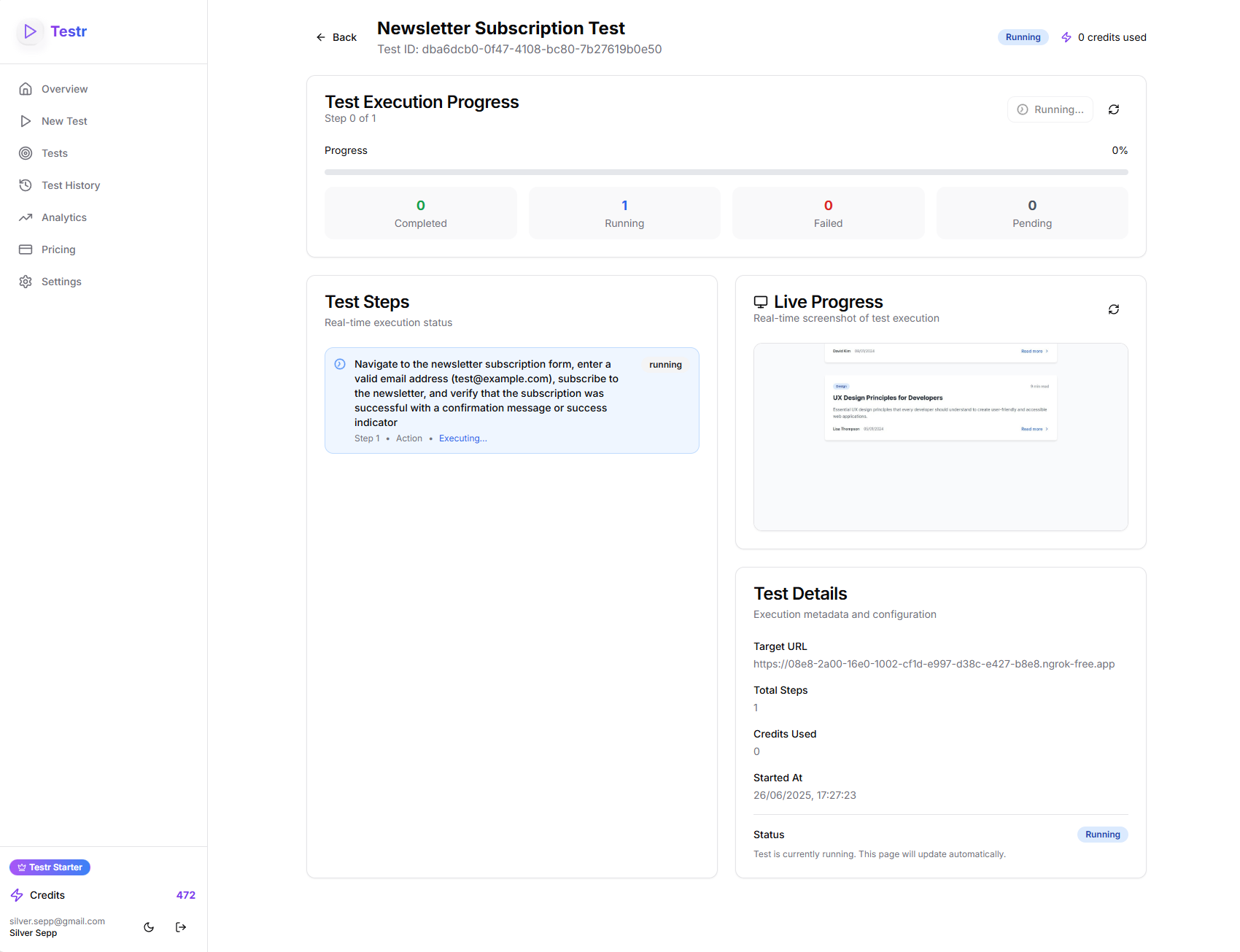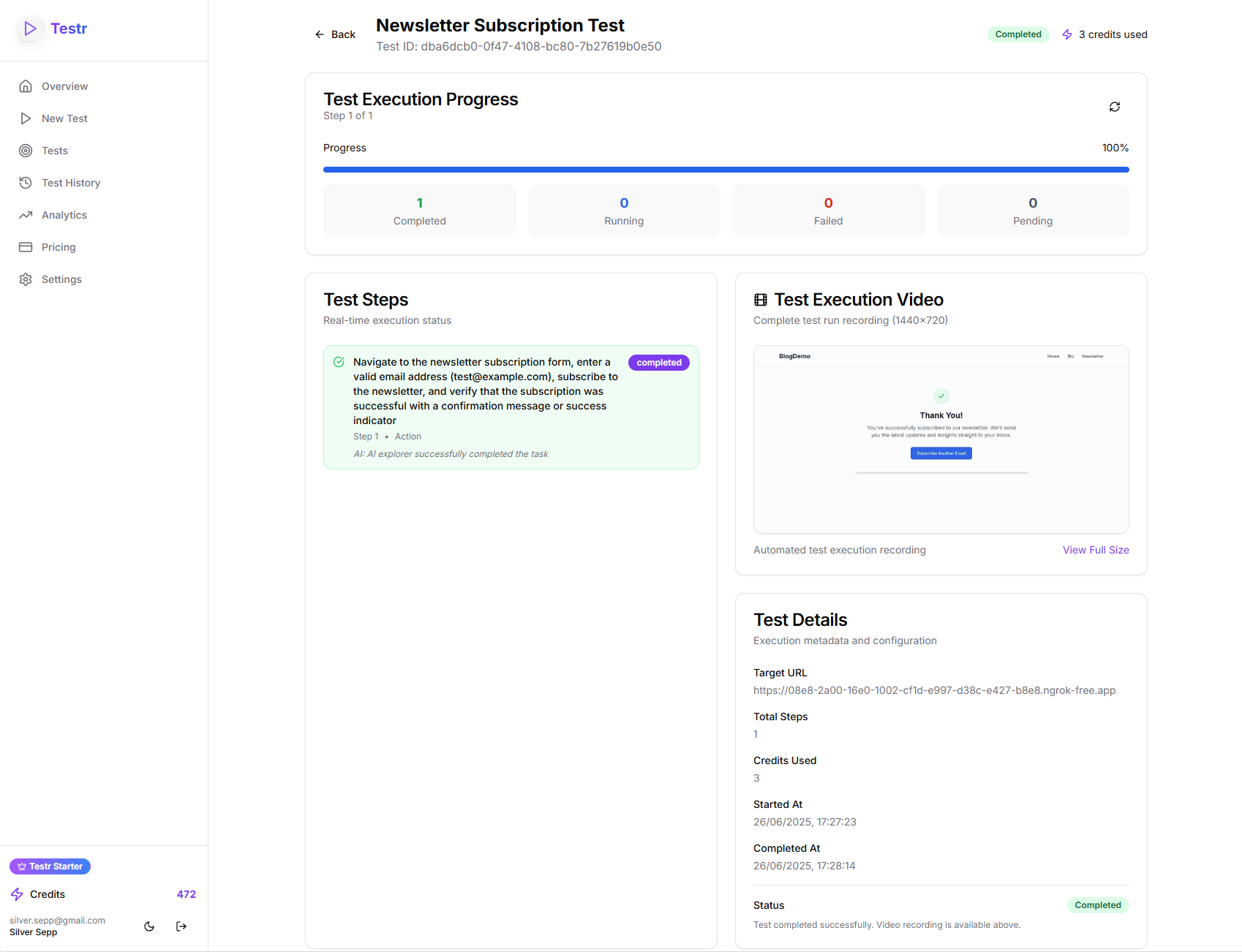Running Tests
Learn how to execute tests, monitor real-time progress, and interpret results for maximum testing effectiveness.
Test Execution Overview
Once you've created a test, Testr provides comprehensive monitoring and analysis throughout the execution process:
- 🎯 Real-time Progress Tracking: Watch your tests execute step-by-step
- 📸 Live Screenshots: See exactly what the browser is doing
- 🎬 Full Video Recording: Get complete GIF recordings of test runs
- 📊 Detailed Analytics: Understand performance and failure patterns
Starting a Test
From Dashboard
- Navigate to your Dashboard
- Find your test in the Recent Tests section
- Click "Run Test" or select from Test Definitions
From Test Creation
Tests automatically start when you click "Create & Run Test" in the test builder.
Via MCP Integration
Create and run a test to verify the login flow works correctlyReal-Time Monitoring
Progress Dashboard
The execution view provides comprehensive real-time monitoring:
📊 Progress Overview
- Completion Percentage: Visual progress bar
- Steps Completed: Current vs. total steps
- Credits Used: Running total of consumed credits
- Execution Time: Elapsed time since start
📈 Step Status Breakdown
- ✅ Completed: Successfully executed steps
- 🔄 Running: Currently executing step
- ❌ Failed: Steps that encountered errors
- ⏳ Pending: Steps waiting to execute
 Real-time test execution monitoring with live screenshots and step-by-step progress
Real-time test execution monitoring with live screenshots and step-by-step progress
Live Screenshots
For running tests, you'll see:
- Current Browser State: Real-time screenshot updates every 5 seconds
- Full Resolution: 1440x720 browser capture
- Manual Refresh: Click refresh to get latest screenshot immediately
Test Status Indicators
🟢 Running
- Test is actively executing
- Live screenshots available
- Progress updates every 3 seconds
- Credits being consumed
✅ Completed
- All steps executed successfully
- Full video recording available
- Final results and analytics ready
- No additional credits consumed
❌ Failed
- Test encountered an error and stopped
- Video recording up to failure point
- Error details in step breakdown
- Partial credit consumption
⏸️ Cancelled
- Test manually stopped or timed out
- Partial execution recorded
- Credits consumed up to cancellation point
Video Recordings
Automatic GIF Generation
Every test execution generates a complete video recording:
- Full Execution: From start to completion/failure
- High Quality: 1440x720 resolution
- Optimized Size: Compressed for fast loading
- Permanent Storage: Videos retained for analysis
Accessing Videos
✅ Completed Tests: Video available immediately after completion ❌ Failed Tests: Video shows execution up to failure point 🔄 Missing Videos: Use "Recreate Video" button if needed
Step-by-Step Analysis
Individual Step Tracking
Each test step provides detailed information:
Step Metadata
- Step Number: Sequential execution order
- Step Type: Action, input, or verification
- Step Text: Human-readable description
- Execution Status: Pending, running, completed, or failed
AI Insights (Explorer Tests)
- AI Reasoning: Why the AI chose specific actions
- Element Selection: How the AI identified page elements
- Decision Process: AI's problem-solving approach
Error Details
- Error Messages: Specific failure reasons
- Screenshots: Visual state when error occurred
- Suggested Fixes: Potential resolution strategies
Common Step Types
🖱️ Action Steps
"Click the login button in the top navigation"
Status: ✅ Completed
AI Reasoning: "Located login button using text 'Sign In' in header"⌨️ Input Steps
"Type 'user@example.com' in the email field"
Status: ✅ Completed
AI Reasoning: "Found email input with placeholder 'Email address'"👁️ Verification Steps
"Verify welcome message appears after login"
Status: ✅ Completed
AI Reasoning: "Detected 'Welcome, User!' text in main content area"Troubleshooting Failed Tests
Common Failure Patterns
🔍 Element Not Found
- Cause: Page structure changed or element doesn't exist
- Solution: Update step descriptions or check target URL
- Prevention: Use more specific element descriptions
⏱️ Timeout Errors
- Cause: Page loading too slowly or infinite loading
- Solution: Check website performance or network connectivity
- Prevention: Test on stable environments
🚫 Access Denied
- Cause: Authentication required or URL blocked
- Solution: Use publicly accessible URLs or handle auth in test steps
- Prevention: Start tests from appropriate landing pages
💳 Insufficient Credits
- Cause: Credit balance too low for test completion
- Solution: Add more credits or reduce test scope
- Prevention: Monitor credit usage and set appropriate budgets
Debugging Strategies
1. Check Live Screenshots
- Review what the browser actually sees
- Compare to expected page state
- Look for loading indicators or error messages
2. Analyze Step Sequence
- Identify where the test first failed
- Review previous steps for context
- Check if test steps match current website state
3. Review AI Reasoning
- Understand AI decision-making process
- Check if AI interpretation matches intent
- Adjust prompts for better AI guidance
4. Test Environment Verification
- Confirm target URL is accessible
- Check for authentication requirements
- Verify page functionality in normal browser
Performance Optimization
Execution Speed
Factors Affecting Speed:
- Website Performance: Server response times
- Network Latency: Connection between Testr and target site
- Test Complexity: Number and type of steps
- Element Detection: How quickly elements are found
Optimization Tips:
- Use specific element selectors
- Minimize unnecessary verification steps
- Test during off-peak hours for target websites
- Choose stable, well-performing target environments
Credit Efficiency
Step-by-Step Tests:
- Remove redundant verification steps
- Combine simple actions where possible
- Focus on critical path validation
Explorer Tests:
- Start with conservative credit budgets
- Increase limits based on actual usage patterns
- Monitor AI efficiency in analytics dashboard
Test Results Analysis
Success Metrics
📊 Completion Rate
- Percentage of steps completed successfully
- Trends over time
- Comparison across different test types
⚡ Performance Metrics
- Average execution time per step
- Total test duration
- Credit efficiency (steps per credit)
🎯 Reliability Indicators
- Success rate across multiple runs
- Consistency of execution times
- Failure pattern analysis
Historical Data
Access comprehensive test history:
- Test Run Archive: All previous executions
- Performance Trends: Speed and success rate over time
- Credit Usage: Historical consumption patterns
- Failure Analysis: Common failure points and causes
 Detailed test results showing execution video, step breakdown, and comprehensive analytics
Detailed test results showing execution video, step breakdown, and comprehensive analytics
Best Practices
Before Running Tests
✅ Environment Preparation
- Verify target website is accessible
- Check for any known outages or maintenance
- Ensure sufficient credit balance
- Review test steps for current website state
During Execution
✅ Active Monitoring
- Watch live screenshots for unexpected behavior
- Monitor step progression and timing
- Be prepared to cancel if issues arise
- Take notes on any unexpected outcomes
After Completion
✅ Results Review
- Analyze full video recording
- Review any failed steps in detail
- Update test definitions based on learnings
- Archive successful patterns for reuse
Integration with Analytics
Test execution data automatically feeds into your analytics dashboard:
- Success Rate Tracking: Monitor test reliability over time
- Performance Metrics: Identify speed and efficiency trends
- Credit Usage Analysis: Optimize testing budgets
- Failure Pattern Recognition: Improve test design
Next Steps
Once you've mastered test execution:
- Explore Analytics - Gain insights from your test data
- MCP Integration - Automate test creation and execution
- Advanced Techniques - Create more sophisticated test scenarios
Ready to dive deeper into your test data? Learn about analytics and insights!